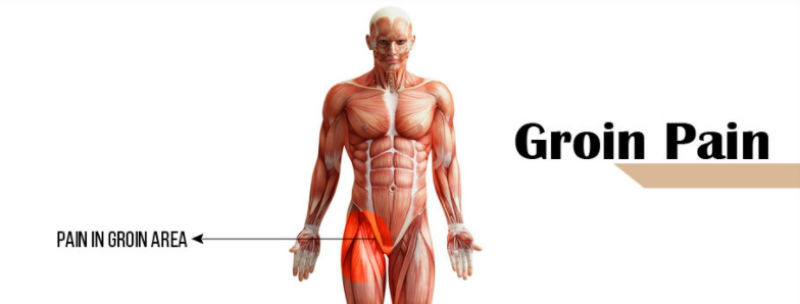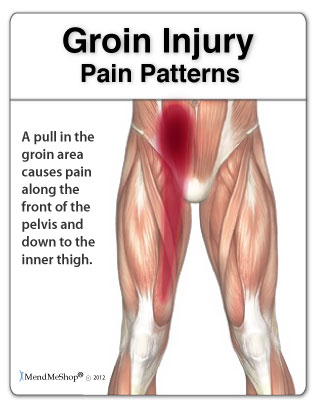
When you feel pain in your groin area, it can often be a cause for panic. While it isn’t always serious, in some cases it can develop to become career-ending in terms of remaining competitive for your given sport or even physically active.
It is important to be able to dictate between a much less serious groin pull and the much more heinous sports hernia that can produce similar symptoms.
Before doing anything else, it is recommended that you visit your general doctor to rule out any serious problems that are indirectly causing this pain.
Furthermore, it is recommended that you take the time to speak with a specialist who can not only conduct an MRI (they will need to be trained in sports hernia MRI radiology) but also an ultrasound while simultaneously performing the Gilmore’s groin test (another term for the nasty, more-serious groin pain diagnosis).
This involves having you do the valsalva maneuver—very simply put, hold your breath while forcing out against your stomach to produce pressure in your abdominal wall. While you are doing this, they will be able to probe the injury site and determine if the tenderness is curable with conservative groin pain treatment.
While the ultrasound provides additional visual confirmation of a posterior inguinal wall deficiency, or a tear in the inguinal cavity that runs along your groin, you can also perform this test very easily from the comfort and privacy of your own home. The video below goes through the process step by step.
What Does a Pulled Groin Muscle Feel Like?
- Sharp pain that originates from your lower abs or inner thigh
- Dull, aching pain that is constant and present at all times
- Pain that increases with movement, especially with running or playing sports requiring quick bouts of agility and direction changes (soccer, football, basketball, etc.)
- Pain in the abs that increases with any form of abdominal exercises or pressure, like when rising from bed
- Pain can sometimes radiate into the testicular region for males
- Pain can sometimes run down the adductors (the inside of your thigh)
- Pain during adduction (when you bring your legs together and touch them)
- Pain during abduction (when you push your legs apart and away from each other)
- Pain when you bring your knee to your chest
Another tell-tale sign is a loud or distinct tearing or “popping” sound or sensation when it happens, then followed immediately by a rush of intense pain to the area.
According to WebMD, the injury falls into one of three categories before being elevated to a more serious diagnosis:
- First Degree: little to mild pain that does not result in a loss of range of motion, movement, strength, or muscular ability
- Second Degree: more intense pain that results in a loss of strength and not only a loss of movement but damage to direct tissues as well
- Third Degree: intense pain that becomes unbearable with movement that leads to an almost complete loss of strength along with a direct tear and possible indirect tears in surrounding tissues
How do you tell the difference between a pull to the groin and a much, much more serious and debilitating sports hernia?
While it would be easy to type up a bogus paragraph with a simple answer, the bare truth is there is no way to provide an accurate answer for each individual given the simple and obvious fact that every single person is different, including how their injury developed and happened and their unique body structure and muscular makeup.
What a Groin Strain Feels Like and How to Fix It
So what is the solution then?
As soon as you determine that the symptoms listed above match the pain you are feeling, it is critical that you immediately begin the groin pain treatment program. While it is developed to rehabilitate those with a full-on case of Gilmore’s groin, the actual 10-week system is designed the exact same.
It is based around the fundamental principle often forgotten: correct movement is corrective.
By strengthening and restoring balance to your posterior chain and the muscles and tendons that surround your hip region, you can also begin to erase your poor posture and form—that led to your pain in the first place.
That’s the real issue with most traditional approaches to sports physical therapy—there is too much emphasis on stretching and rest with little on developing functional strength that provides structural health.
Rest, Ice, Compression, and Elevation (the words behind the infamous “RICE” prescription from general physicians and doctors) are undoubtedly valuable but come into play only during a limited period of time post-injury. During the initial inflammatory response after you get injured (48-96 hours, highly person dependent), rest should be highly emphasized where RICE is followed with strict adherence.
But once that short time is up, only true long-term benefits can be gained by retraining and remodeling your “broken” muscular system.
Amazing Stretch for Groin Pain Relief
While performing the program linked above is critical to healing your groin pain, another huge aspect behind a successful physical therapy approach is mobility work.
If you haven’t already, check out the 10-move mobility routine as soon as you can and begin to follow the list outlined. Do them yourself immediately before performing the exercises listed in the groin rehab program.
But to get you some immediate, lasting relief, here is a video that covers one of the best stretches to relive these symptoms.
Backing up, how does it happen in the first place?
Often times, there is a specific “cataclysmic” event that leads to a distinct tear in one of several muscles that make up that area of the body:
- Adductors (inner thigh)
- Rectus Abdominis (lower abs)
- Psoas
- Hip Flexors
- Abductors
This is not an all-inclusive list, as other causes can include tight and inhibited glutes as well as weak or shortened hamstrings. The bottom line is that your body’s musculoskeletal system is not symmetrical. Over time, this “unevenness” leads to asymmetrical muscular development (one side of your body is larger or smaller than the other).
And as this happens, your posture and form during exercise or even basic movements such as walking and moving side to side will continue to become worse.
That’s where the “event” comes into place: after months or even years of this poor movement, the sudden swift movement places too much pressure and stress on the groin area and upper thigh. When this force becomes too much, they may become stretched past a safe range of motion or even tear causing more long-term issues.
If tears are the case, it is very likely the diagnosis could become elevated to a sports hernia.

Diagram 1 (credit: aidmygroin.com)
The groin pain location can be seen visually from the diagram 1.
Many of the specific activities that set off the injury often times include a swift kicking motion, such as running or playing soccer or hockey.
The number one factor determining whether it is serious is whether or not you are able to heal within 6-10 weeks following the proper rehabilitation protocol.
If you do end up having to seek further treatment for a sports hernia, it is at least good to know that it can’t “get worse”—if a non-surgical approach is unsuccessful, you don’t have to stress about things going even farther downhill.
When it comes to being able to heal, bottom line, it comes down to how quickly you diagnose and treat your pain. If you begin the 10-week pulled groin treatment plan immediately, your chances of recovery will increase exponentially.
This isn’t just marketing lingo. One of the most pronounced studies of medical research in this area came to the ultimate conclusion that the length of time between injury and proper diagnosis—how quickly you begin rehabbing correctly following getting injured—was the number one factor in whether or not people needed to get surgery for groin pain.
